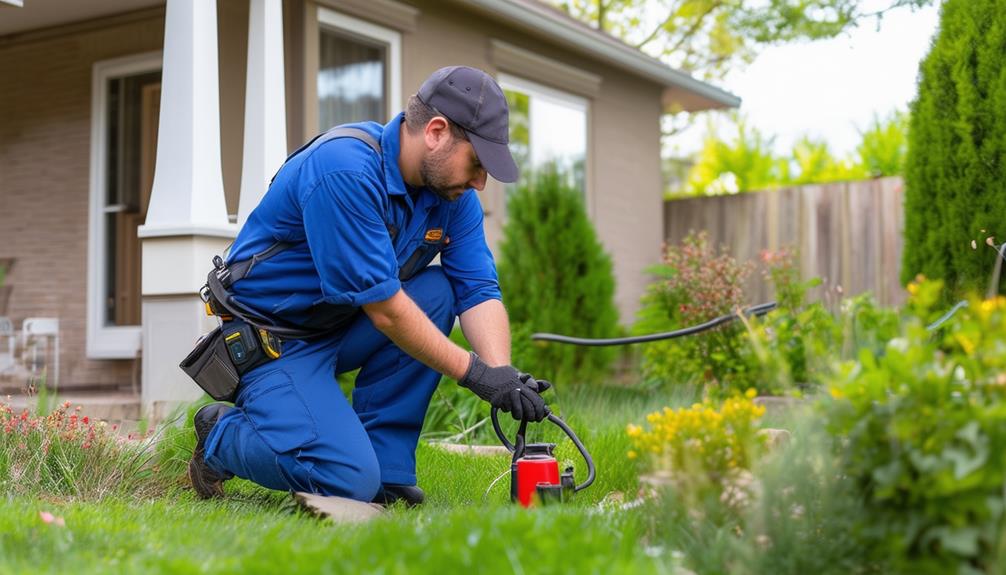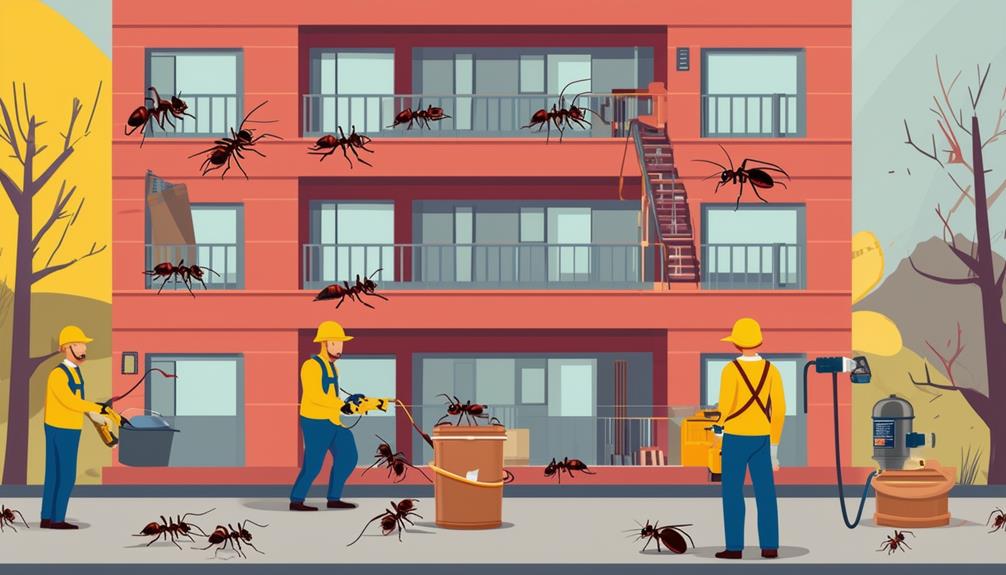Pest control serves as an essential component in maintaining public health standards in Utah, offering a shield against potential health risks. With the intricate interplay between pests and disease transmission, the role of pest control professionals is paramount in ensuring community well-being. In Utah, the management of pests extends beyond mere eradication efforts, encompassing a holistic approach that tackles the root causes of health hazards. As you explore the intricacies of pest control's impact on public health in Utah, you will uncover the multifaceted strategies employed to safeguard the population.
Key Takeaways
- Pest control safeguards public health by curbing disease transmission.
- Integrated Pest Management plans address pest threats effectively.
- Regulations in Utah uphold standards of pest control practices.
- Pest management programs in Utah protect public health and property.
- Community involvement in pest control fosters a sense of responsibility.
Importance of Pest Control
Pest control is paramount in safeguarding public health by curbing the transmission of diseases carried by various pests such as rodents, mosquitoes, and ticks. Getting rid of these pests is essential to minimizing the risk of vector-borne diseases and ensuring the well-being of the population. In Utah, effective pest control measures are necessary for maintaining a healthy environment and reducing the impact of climate change on pest prevalence.
Proper pest control not only protects public health but also safeguards property from damages caused by pests. Integrated Pest Management plans play an important role in addressing pest threats in Utah, where regulations are in place to uphold the standards of pest control practices. By following these guidelines, residents can be assured of a safe living environment free from the dangers posed by pests carrying diseases like West Nile Virus.
Vector-Borne Diseases in Utah
In Utah, the prevalence of vector-borne diseases, such as West Nile Virus transmitted by mosquitoes, poses significant health risks to both humans and wildlife. West Nile Virus has been a concern in Utah, with documented cases affecting individuals and wildlife. This disease, transmitted through mosquito bites, can lead to serious complications, including neurological issues and, in rare cases, death.
The distribution and prevalence of vector-borne diseases in Utah are influenced by factors like climate change, which impacts the habitats and populations of disease-carrying vectors. Effective mosquito surveillance and control strategies are vital in managing the spread of these diseases. Public health initiatives in Utah emphasize educating the community on preventive measures, such as eliminating standing water where mosquitoes breed and using insect repellent when outdoors.
Impact of Climate Change
As climate change progresses, Utah's ecosystems are witnessing alterations that directly impact the behavior and prevalence of pests. The rising temperatures are likely to shift the distribution and abundance of disease-carrying vectors across the state.
These changes in environmental conditions are expected to influence the reproductive patterns of pests and the transmission dynamics of vector-borne diseases.
Climate Change Effects
Amidst the changing climate conditions in Utah, the prevalence and distribution of pests are undergoing significant shifts, impacting public health strategies for pest control. Climate change implications in the state can lead to alterations in ecosystems, influencing the dynamics of pest populations.
Rising temperatures may disrupt the behavior and life cycles of disease-carrying vectors, posing public health challenges in controlling vector-borne diseases. Changes in weather patterns, driven by climate change, have the potential to affect the spread of vector-borne illnesses in Utah.
Long-term climate trends play a critical role in determining the abundance of certain pests, necessitating a deep understanding of the relationship between climate change and pest dynamics for the development of effective pest control strategies to safeguard public health in Utah.
Adaptation Strategies
Considering the evolving climate conditions in Utah, the adaptation strategies for pest control must address the shifting dynamics of pest populations to effectively manage public health risks. Pest adaptation to changing environmental conditions, influenced by climate resilience, plays an essential role in disease management.
As climate change impacts pest behavior and distribution, there's a pressing need to enhance adaptive measures to mitigate the spread of vector-borne diseases. Rising temperatures directly impact pest reproduction rates, leading to an increase in disease transmission by vectors.
Role of Mosquito Control
When reflecting on the role of mosquito control in public health, it's essential to emphasize the prevention of mosquito-borne diseases such as West Nile Virus and Zika Virus.
Implementing larviciding techniques to target mosquito larvae in breeding sites is a vital aspect of effective control strategies.
Additionally, public awareness campaigns play a significant role in educating communities about reducing mosquito populations and protecting themselves from bites.
Mosquito-Borne Diseases Prevention
Mosquito control programs in Utah employ various strategies to mitigate the spread of mosquito-borne diseases, particularly focusing on targeting mosquito breeding sites and adult populations. Mosquito surveillance is key in identifying high-risk areas for disease transmission, allowing for targeted interventions.
Larviciding, which involves treating mosquito breeding sites with pesticides to kill larvae, and adulticiding, which targets adult mosquitoes, are commonly used methods in mosquito control. Personal protection measures, such as using insect repellent and wearing protective clothing, are vital in preventing mosquito bites and reducing the risk of disease transmission.
It's essential for collaborative efforts between local health departments, vector control agencies, and communities to work together to effectively prevent mosquito-borne diseases like West Nile Virus.
Larvae Control Methods
Implementing larvae control methods is crucial in the field of mosquito control to effectively reduce adult mosquito populations and minimize public health risks. Biological control and larvicide efficacy play a crucial role in targeting mosquito larvae to prevent disease transmission and reduce nuisance from adult mosquitoes.
An integrated approach focusing on identifying and treating breeding sites with larvicides disrupts the mosquito life cycle. Water treatment is a key aspect of larvae control, as standing water serves as a prime breeding ground for mosquitoes. Efforts are made to choose environmentally friendly larvicides to minimize the impact on the surrounding ecosystem.
Public Awareness Campaigns
Utilizing targeted public awareness campaigns is essential in effectively engaging residents and reducing potential mosquito breeding sites to mitigate the transmission of vector-borne diseases like West Nile Virus in Utah.
Community engagement through educational outreach programs is paramount to inform the public about identifying and eliminating mosquito breeding sites around their homes and communities.
By raising awareness about the importance of mosquito surveillance and data analysis in monitoring mosquito populations, residents can actively participate in disease prevention efforts.
Through these campaigns, individuals are empowered to take proactive steps in controlling mosquitoes, thereby contributing to the overall public health strategy to combat diseases like West Nile Virus.
Such initiatives are pivotal in adapting to changing vector distributions influenced by climate fluctuations and ensuring the well-being of the population.
Tick Control Measures
Tick control measures in Utah primarily focus on reducing tick habitats in grassy and wooded areas where ticks thrive. Engaging in outdoor activities increases the risk of tick exposure, making tick prevention essential. Wearing protective clothing such as long sleeves, pants, and insect repellent can help deter tick bites. After outdoor activities, conducting thorough tick checks on pets and family members is imperative for early detection and removal. In residential areas, implementing tick control products like acaricides and tick tubes can effectively manage tick populations. Additionally, adopting landscaping practices that discourage tick-friendly environments, like keeping grass trimmed and removing leaf litter, supports tick control efforts. Below is a table summarizing essential tick control measures:
| Tick Control Measures | Description | Importance |
|---|---|---|
| Protective Clothing | Wearing long sleeves, pants, and insect repellent | Prevents tick bites |
| Regular Tick Checks | Inspecting pets and family members after outdoor activities | Early detection and removal |
| Tick Control Products | Using acaricides and tick tubes for tick population management | Effective tick control |
Disease Prevention Strategies
Effective management of disease risks associated with pests in Utah requires a thorough approach integrating pest surveillance, disease monitoring, and prevention strategies. Pest surveillance involves regular inspections and monitoring to identify potential health risks posed by pests. Disease monitoring is important in tracking the prevalence of vector-borne illnesses spread by pests like mosquitoes and ticks. Prevention strategies encompass implementing Integrated Pest Management (IPM) plans, adhering to pesticide regulations, and providing proper training for pest control contractors.
Communication plays an important role in enhancing public health outcomes related to pest control. Effective engagement with residents and school occupants about pest control measures fosters a better understanding of disease prevention strategies. By identifying and evaluating pest risks, documenting pest control activities, and ensuring compliance with health standards, Utah can maintain a proactive stance in safeguarding public health. This all-encompassing approach to disease prevention through pest control is crucial in mitigating health risks associated with pests in the state.
Community Health Benefits
Proper management of pests in Utah communities plays an essential role in enhancing public health outcomes and preventing the spread of diseases carried by vectors such as rodents, mosquitoes, and ticks. This is achieved through a combination of community engagement, environmental sustainability, and public education. Here's how these aspects contribute to the community health benefits in Utah:
- Community Engagement: Involving residents in pest control programs fosters a sense of ownership and responsibility, leading to more effective and sustainable outcomes.
- Environmental Sustainability: Implementing integrated pest management practices reduces reliance on harmful chemicals, preserving the ecosystem and promoting long-term health for both humans and the environment.
- Community Partnerships: Collaborating with local organizations and public health agencies enables the implementation of holistic pest control strategies, emphasizing an integrated approach for the betterment of public health in Utah.
Public Health Regulations
How do public health regulations in Utah guide the management of pests to safeguard community well-being and environmental integrity?
Pest control regulations in Utah, specifically outlined in the Utah Administrative Code 392-200-18, serve as an essential framework for addressing pests that pose threats to public health and property. Integrated Pest Management (IPM) plans are mandated, with local health officers empowered to request and adjust them as needed. Pest control contractors must strictly adhere to guidelines set by the Utah Department of Agriculture and Food, focusing on pests that are either nuisances or present health risks.
Public health guidelines emphasize the importance of applying pesticides at schools in strict accordance with labeled directions and pesticide regulations. It's the responsibility of the governing body to oversee the implementation of the overall IPM plan, ensuring that any necessary modifications are made to prioritize safety. By enforcing these regulations, Utah aims to maintain a balance between effectively managing pests and protecting public health and the environment.
Pest Management Programs
In Utah, the focus of pest management programs lies in addressing pests that present threats to public health and property, with a particular emphasis on developing Integrated Pest Management (IPM) plans for effective control in various settings.
Pest prevention, surveillance, and response are integral components of these programs:
- Pest Prevention: Strategies such as sanitation, habitat modification, and exclusion techniques are implemented to prevent pest infestations before they occur. By focusing on prevention, the need for extensive pest control measures can be minimized.
- Pest Surveillance: Regular monitoring and inspection are conducted to detect pest presence early. Surveillance allows for timely intervention, helping to prevent pests from establishing large populations that could pose significant health risks.
- Pest Response: When pests are identified, prompt and targeted responses are essential. This may involve applying appropriate control measures as outlined in the IPM plans, which are designed to effectively manage pests while minimizing risks to public health and the environment.
Frequently Asked Questions
What Are Significant Public Health Problems Caused by Pests?
Pests like rodents, mosquitoes, and bed bugs contribute to disease transmission, allergic reactions, and food contamination. These issues pose significant public health risks, emphasizing the importance of effective pest control measures to safeguard communities.
What Is the Role in Pest Control?
Imagine you're the guardian of a delicate ecosystem. Your duty includes implementing prevention methods, considering the environmental impact, and educating the community. This intricate dance of science and care is the essence of effective pest control.
What Strategy Is Sometimes Justified for Pests That Affect Public Health?
When pests impact public health, Integrated Pest Management (IPM) is a strategy that may be warranted. This approach emphasizes long-term prevention through techniques like biological control, habitat modifications, and, as a last resort, chemical treatments.
What Are the Health Risks of Pest Control?
When it comes to health risks associated with pest control, you face various dangers like respiratory issues, skin irritation, and allergic reactions. Exposure to chemicals and pests can lead to long-term health effects, emphasizing the importance of safety measures.




